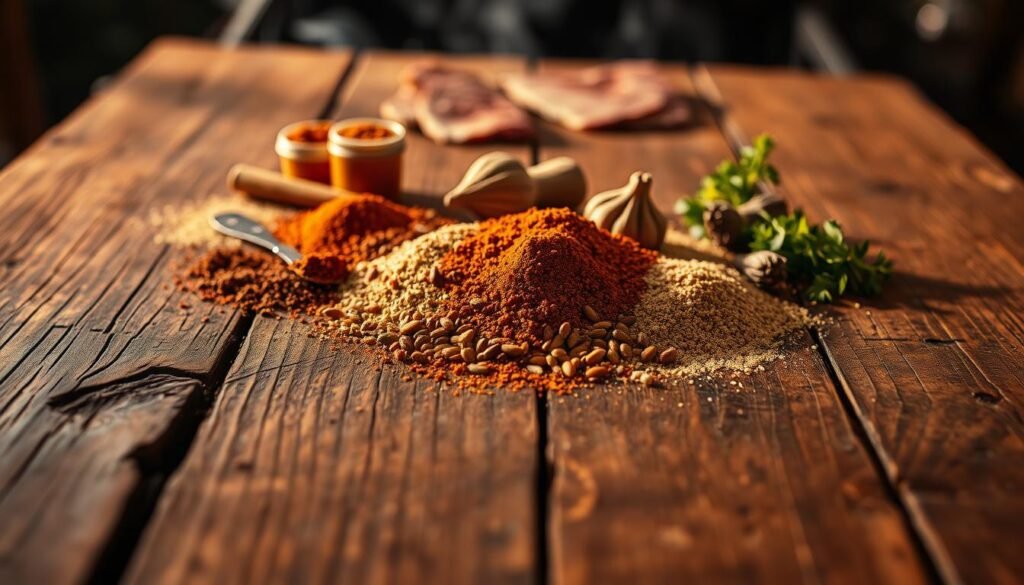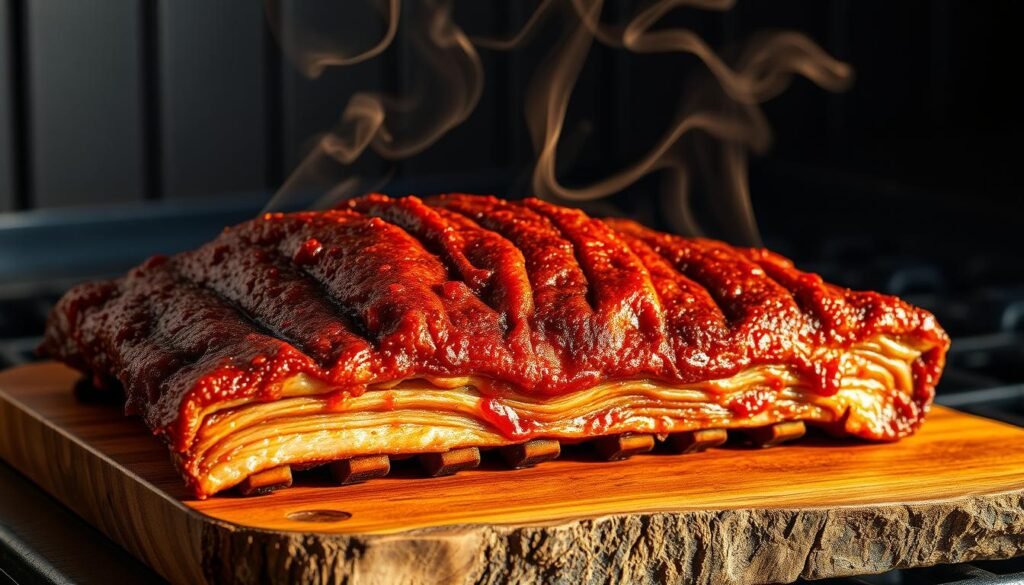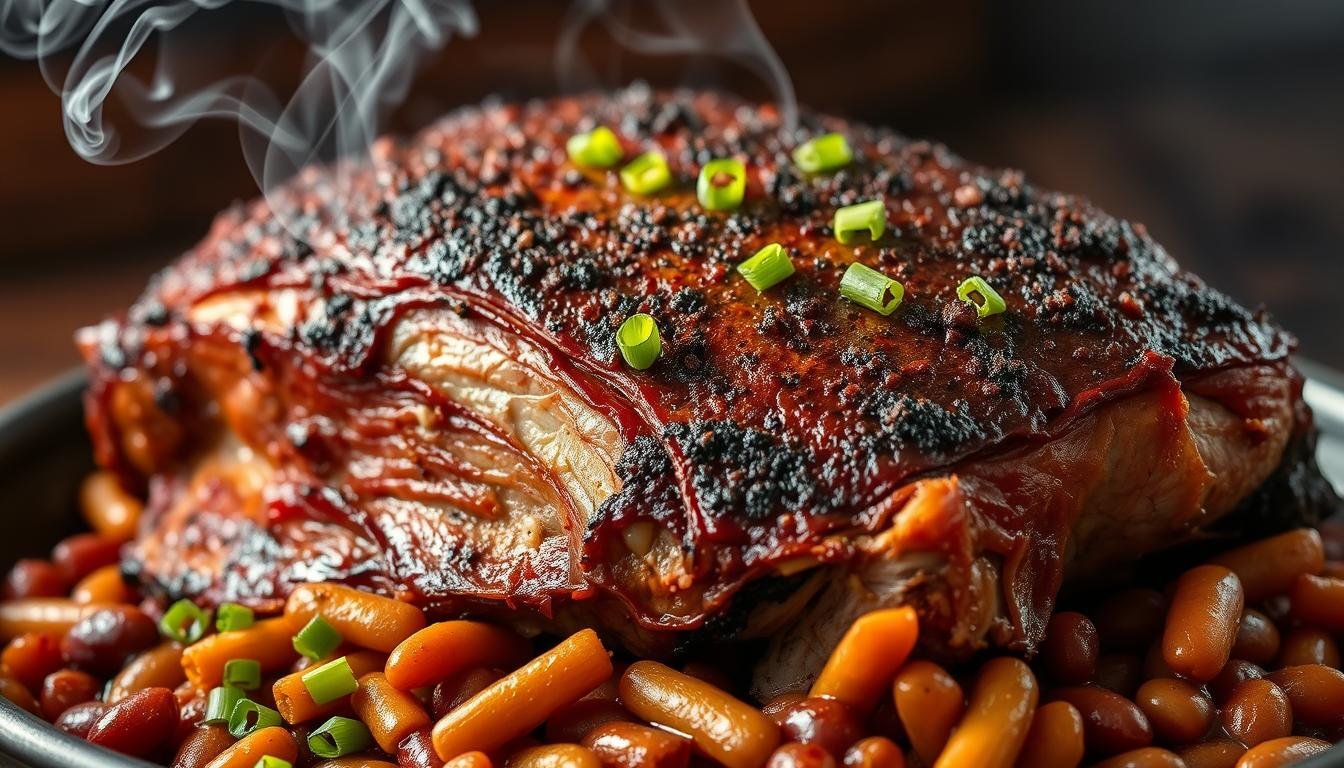Ready to wow your family and friends with tender, fall-off-the-bone smoked BBQ ribs? With low and slow cooking techniques, you can make mouth-watering ribs right in your backyard!
Steven Raichlen, a BBQ expert, says brisket and ribs need special knowledge to cook right. In this guide, we’ll show you how to pick the best ribs, prep them for the smoker, and serve them like a pro. You’ll learn the secrets to tender, delicious ribs that everyone will love!
Key Takeaways
- Learn the basics of low and slow cooking for tender BBQ ribs
- Understand how to select the right type of ribs for smoking
- Discover preparation techniques for optimal flavor
- Master the art of serving smoked BBQ ribs like a pro
- Impress your family and friends with your new BBQ skills!
Introduction to BBQ Smoked Ribs
Smoked ribs are a true culinary delight. They combine tender meat with a rich, complex flavor. As a BBQ enthusiast, you’ll find the smoking process transforms ribs into a mouth-watering treat.
So, why do smoked ribs stand out in BBQ? Let’s explore why they’re so popular and the smoking process that makes them irresistible.
Why Choose Smoked Ribs?
Smoked ribs are a favorite for many BBQ lovers. The slow smoking process makes the meat tender and easy to pull off the bone. It also infuses the ribs with a deep, smoky flavor that’s hard to get with other cooking methods.
According to Christie Vanover, a competitive pitmaster, “choosing the right cut and understanding the science behind smoking is key for perfect brisket.” The same goes for ribs. This results in a deliciously tender and flavorful meal, perfect for any occasion.
“The key to great BBQ is low and slow cooking, which allows the meat to absorb all the flavors.” –
Overview of the Smoking Process
The smoking process cooks the ribs at a low temperature for hours, usually several. This slow cooking breaks down the collagen in the meat, making it tender and flavorful.
| Smoking Technique | Description | Benefits |
|---|---|---|
| Low and Slow | Cooking at low temperatures (225-250°F) for several hours. | Tender, flavorful meat that’s easy to pull off the bone. |
| Wood Selection | Choosing the right type of wood for smoking, such as hickory or apple. | Adds a rich, complex flavor profile to the ribs. |
To get the best results, understanding the basics of the smoking process is key. In the next sections, we’ll dive into selecting the right ribs, preparing them for smoking, and mastering the smoking technique.
Selecting the Right Ribs
Choosing the right ribs is the first step in your BBQ journey. It sets the stage for a memorable dining experience. The type of ribs you pick can greatly affect the flavor, tenderness, and success of your smoked BBQ ribs.
Steven Raichlen said the meat cut is key. He recommended a whole packer brisket, but this principle also applies to ribs. The right cut makes a big difference.
Baby Back Ribs vs. Spare Ribs
When it comes to BBQ ribs, you have two main choices: baby back ribs and spare ribs. Baby back ribs are leaner, more tender, and pricier. They’re called “baby back” because they’re shorter and come from the upper part of the rib cage, near the spine.
Spare ribs are larger, fattier, and often more flavorful. They come from the lower part of the rib cage and have more cartilage. This makes them tender when cooked low and slow.
| Characteristics | Baby Back Ribs | Spare Ribs |
|---|---|---|
| Leaness | Leaner | Fattier |
| Tenderness | More Tender | Can be more tender with slow cooking |
| Price | Generally more expensive | Less expensive |
What to Look for When Buying Ribs
Whether you choose baby back ribs or spare ribs, there are important things to look for:
- Meat color: Look for ribs with a fresh, red color.
- Marbling: A good amount of marbling (fat distribution) can enhance flavor and tenderness.
- Membrane: Ensure the membrane is intact on the back of the ribs, as it’s easier to remove before cooking.
“The quality of the ribs you start with will directly impact the final product. Freshness and proper handling are key.” –
When preparing your ribs, remember the importance of a good pork shoulder rub or a specific rub designed for ribs. While the focus is on ribs, learning how to season a smoked pork shoulder can also offer insights into BBQ.
Essential Tools for Smoking Ribs
To get tender, fall-off-the-bone ribs, you need the right smoker and accessories. You’ll want to pick a few key tools for that perfect smoky taste. These tools are what make your BBQ stand out.
Offset Smokers vs. Pellet Smokers
When smoking ribs, you have two main choices: offset smokers and pellet smokers. Offset smokers give a deep, smoky flavor because they’re right in the smoke. They’re great for those who love the art of smoking and can keep an eye on the temperature.
Pellet smokers offer a simpler and more controlled way to smoke. They burn compressed wood pellets and keep a steady temperature. This makes them perfect for beginners or anyone who wants an easy smoking experience.
| Feature | Offset Smokers | Pellet Smokers |
|---|---|---|
| Temperature Control | Manual, requires monitoring | Automated, consistent temperature |
| Flavor Profile | Rich, traditional smoky flavor | Mild, subtle smoky flavor |
| Ease of Use | Requires experience and monitoring | User-friendly, ideal for beginners |
Recommended Accessories for Success
There are many accessories that can improve your smoking experience. A meat thermometer is key to ensure your ribs are cooked right. Rib racks help cook ribs evenly and can also increase your smoker’s capacity. A smoke generator adds extra flavor to your ribs.
BBQ experts say the right tools are vital for great BBQ. Sites like Smoking-Meat.com provide great advice on the best tools for smoking. This helps you make smart choices for your next BBQ.
“The key to great BBQ is not just the meat or the sauce, but the love and care you put into the cooking process.”
Getting the right tools and knowing how to use them can take your BBQ to the next level. Whether you’re an expert or just starting, the right equipment is the first step to that perfect, slow-cooked flavor.
Preparing the Ribs
The secret to tender, juicy ribs is in the prep work! Getting your ribs ready right is key for that tender, fall-off-the-bone feel. We’ll cover the important steps, like removing the membrane and adding a tasty dry rub.
Removing the Membrane
Removing the membrane from the back of the ribs is a must. This membrane, or pleura, can make the ribs tough and block the rub from getting to the meat. To remove it, slide a knife under and gently pry it loose. Once you have a good grip, pull it off in one piece. If it’s hard, use a paper towel for better grip!
Rubbing with Spices: Tips and Tricks
After removing the membrane, it’s time for the dry rub. A great dry rub can really boost the flavor of your ribs. You can mix different spices and herbs to create a unique taste. Popular choices include paprika, brown sugar, garlic powder, and chili powder. The goal is to find a mix that complements the ribs’ natural taste.
Here are some tips for applying your dry rub:
- Generously sprinkle the rub all over the ribs, making sure to cover every surface.
- Gently massage the rub into the meat to ensure it adheres well.
- Let the ribs sit for a while to allow the flavors to penetrate the meat.
Just like a good pork shoulder marinade can enhance the flavor of your pork shoulder, a well-applied dry rub can make your ribs incredibly flavorful. The key is to be generous and ensure the rub is evenly distributed. By following these steps, you’ll be on your way to creating juicy BBQ pork shoulder and ribs that will impress anyone!
Choosing the Right Wood for Smoking
The right wood can make your smoked ribs amazing. It’s as important as the rub or the temperature. The wood adds a unique flavor that can make or break your BBQ.
Flavor Profiles: Apple, Hickory, and Mesquite
Different woods give different flavors to your ribs. Let’s look at some popular ones:
- Apple Wood: It has a mild, fruity taste. Apple wood is great for those who like a light smoke flavor. It adds sweetness without overpowering the meat.
- Hickory: A classic choice, hickory gives a strong, savory taste. It’s perfect for those who want a bold smoke flavor.
- Mesquite: Mesquite has a strong, earthy taste. It’s used in small amounts to add a bold smoky taste. But, it’s very potent, so use it sparingly.
Mixing Woods for a Unique Flavor
Why use just one wood? Mixing woods can create a unique flavor. For example, apple and hickory together offer a mild, fruity taste with a hint of robustness. Try different combinations to find your favorite!
Remember, great BBQ takes patience and practice. Don’t be afraid to try new things and adjust your technique. With the right wood and a bit of know-how, you’ll make delicious, low and slow BBQ that will impress everyone.
The Perfect BBQ Rib Rub Recipe
A great BBQ rib rub can make all the difference in your smoked ribs. I’m excited to share my recipe with you! A well-crafted rub is essential for delicious smoked ribs, adding depth and complexity to the meat.
Creating the perfect rub is all about balancing flavors. You want a mix that complements the natural taste of the ribs without overpowering them. According to BBQGuys.com, a good rub can elevate your BBQ. With the right ingredients, you can achieve that perfect balance.
Ingredients You’ll Need
To make your own BBQ rib rub, you’ll need a blend of spices and herbs. Here’s a list of the ingredients you’ll need:
- 2 tablespoons brown sugar
- 1 tablespoon smoked paprika
- 1 tablespoon kosher salt
- 1 tablespoon black pepper
- 1 tablespoon garlic powder
- 1 tablespoon onion powder
- 1 tablespoon chili powder
- 1 teaspoon cayenne pepper (optional)
| Ingredient | Quantity | Purpose |
|---|---|---|
| Brown Sugar | 2 tbsp | Adds sweetness |
| Smoked Paprika | 1 tbsp | Provides smoky flavor |
| Kosher Salt | 1 tbsp | Enhances flavor |
| Black Pepper | 1 tbsp | Adds depth |
How to Make Your Own Rub
Once you have all your ingredients, making the rub is straightforward. Simply combine all the ingredients in a bowl and mix until they’re well blended.
Tip: You can adjust the quantities to suit your taste preferences. If you like a bit of heat, add more cayenne pepper!
“The right rub can make your BBQ stand out. Experiment with different ingredients to find your perfect blend.” – BBQGuys.com
Now that you have your rub, you’re ready to prepare your ribs for smoking. Remember, the key to tender, flavorful ribs is in the preparation and the rub.

Getting Your Smoker Ready
Preparing your smoker is key to tender, flavorful ribs. It’s not just about throwing wood and meat on the grill. Your smoker needs to be set up right for the task!
Setting the Right Temperature
Temperature control is critical in smoking. For tender ribs, keep the temperature between 225°F to 250°F. This low and slow method breaks down meat tissues, making it tender.
Using a reliable thermometer is essential. I always suggest having a backup for accuracy!
Preheating Your Smoker: Why It Matters
Preheating your smoker is as important as preheating your oven. It makes sure your smoker is ready to cook ribs evenly. For a pork shoulder rub to work, the smoker must be at the right temperature.
Skipping this step can cause uneven cooking and less flavor. Achieving a perfect smoked pork shoulder needs a well-preheated smoker.
Smoking the Ribs
Now that your smoker is ready, it’s time to learn how to smoke ribs perfectly! Smoking ribs might seem scary if you’re new to it. But with the right tips, you’ll make tender, tasty ribs that everyone will love.
How Long to Smoke Ribs
The time it takes to smoke ribs varies. It depends on the type of ribs and your smoker’s temperature. Baby back ribs usually take 4-5 hours at 225°F. Spare ribs might need 5-6 hours at the same temperature.
Remember, these times are just a guide. The actual cooking time can change.
Factors that affect cooking time include:
- The thickness of the ribs
- The temperature consistency of your smoker
- The type of wood used for smoking
As pitmaster Jack McDowell said, “The key to great BBQ is low and slow cooking.” This is very true for smoking ribs.
Ensuring Even Cooking with Techniques
To get evenly cooked ribs, use a few simple tricks. First, put the ribs in the smoker bone side down. This keeps the meat away from direct heat. You can also wrap the ribs in foil for the last hour to keep them moist, known as the ‘Texas Crutch.’

For a slow cooked pork shoulder or ribs, keeping the temperature steady is important. This ensures the meat cooks evenly. An easy pork shoulder recipe often involves a simple rub and patience.
By following these tips, you’ll make delicious smoked ribs. They’re sure to impress even the pickiest eaters.
Basting and Spritzing for Flavor
Basting and spritzing are great for BBQ beginners and experts alike. They add moisture and flavor to your smoked ribs. This makes them tender and delicious every time.
When to Baste: Timing Tips
Basting your ribs with a flavorful marinade or sauce boosts their taste and keeps them moist. It’s key to baste at the right time. Start basting during the last 30 minutes to 1 hour of smoking.
This lets the sauce set and caramelize, creating a sticky, sweet glaze. Use a mop or brush to coat the ribs evenly. Be gentle to avoid damaging the meat. Baste consistently for a uniform flavor.
Spritzing Mixtures: Ideas for Moisture
Spritzing helps keep your ribs juicy and adds flavor. You can use a simple mix like apple cider vinegar and water or a complex blend of juices, spices, and herbs. The goal is to enhance the ribs without overpowering them.
Popular spritzing mixtures include apple juice and BBQ sauce or water, vinegar, and spices. You can also try beer, honey, or hot sauce for a unique taste. Remember, the aim is to improve the ribs, not overwhelm them.
Adding basting and spritzing to your rib-smoking routine can balance flavor and moisture. Try different techniques and ingredients to find what works for you. Don’t be afraid to experiment!
Checking for Doneness
It’s time to see if your ribs are done. There are a few ways to check if they’re cooked just right. You want them to be tender and fall-off-the-bone. We’ll look at two methods: The Texas Crutch Method and using a meat thermometer.
The Texas Crutch Method
The Texas Crutch Method wraps your ribs in foil to make them tender and cook faster. It’s great if you’re in a hurry or want extra tender ribs. Wrap your ribs in foil after 2 hours of smoking.
This helps keep moisture in and cooks them evenly.
Here’s how to use the Texas Crutch:
- Smoke your ribs for 2 hours at your desired temperature.
- Wrap them tightly in foil.
- Continue smoking for another hour or until they reach your desired level of tenderness.
- Unwrap and finish with a glaze if desired.
Using a Meat Thermometer Effectively
A meat thermometer is the most accurate way to check if your ribs are done. For pork ribs, they should be around 190°F to 203°F for tenderness. Make sure the thermometer is in the thickest part of the rib, away from bones or fat.
| Meat Type | Internal Temperature | Tenderness Level |
|---|---|---|
| Pork Ribs | 190°F – 203°F | Tender, fall-off-the-bone |
| Pork Shoulder | 195°F – 205°F | Very tender, shreds easily |
By using both methods, you’ll get perfectly cooked ribs every time. Whether you’re making a low and slow BBQ pork shoulder recipe or smoking pork shoulder, these tips will help you succeed.
Serving and Enjoying Your Smoked Ribs
Now that your ribs are perfectly smoked, it’s time to serve and enjoy the fruits of your labor! A great BBQ experience is not just about the main course. It’s also about the sides and how you present your dish.
Pairing Ribs with Delicious Sides
For a classic BBQ experience, consider pairing your ribs with sides like coleslaw, baked beans, or grilled vegetables. Websites like BBQGuys.com offer a wealth of ideas for side dishes that complement your smoked ribs nicely. You can also draw inspiration from other BBQ favorites, such as a pulled pork recipe or the best BBQ pork shoulder.
Tips for Saucing, Slicing, and Serving
When it comes to saucing, slicing, and serving, the key is to keep things simple yet flavorful. Slice your ribs against the bone, and serve with your favorite BBQ sauce on the side. Consider adding some fresh herbs or a sprinkle of spices to give your dish a personal touch.
